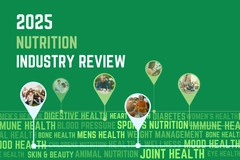
- Industry news
Industry news
- Category news
- Reports
- Key trends
- Multimedia
Multimedia
- Journal
- Events
- Suppliers
Suppliers
- Home
- Industry news
Industry news
- Category news
- Reports
- Key trends
- Multimedia
Multimedia
- Events
- Suppliers
Suppliers
Hidden hunger: Micronutrient deficiency found to impact preschool children and reproductive women worldwide

13 Oct 2022 --- A study published in Lancet Global Health has revealed that half of preschool-aged children and two out of three women of reproductive age are experiencing “hidden hunger” – nutrient and mineral deficiency of either zinc, iron, folate or vitamin A – globally.
“Women of reproductive age have increased iron requirements, and folate deficiency during this period can increase the risk for neural tube defects in a developing fetus if a woman becomes pregnant,” Ty Beal, research advisor of knowledge and leadership at the Global Alliance for Improved Nutrition (GAIN), tells NutritionInsight.
He explains that pregnant and lactating women, infants and young children between 6-23 months old are potentially more affected because of substantially increased nutrient requirements. “But we did not analyze these population subgroups separately in this study,” Beal details.
“Diets that don’t provide the right levels of vitamins and minerals can compromise your immune system, impair your cognition and school performance, decrease your work productivity, and may contribute to risks of non-communicable diseases such as heart problems,” says Lynnette Neufeld, director of food and nutrition division at the Food and Agriculture Organization of the UN.
“This is a widespread problem, impacting individuals, families and communities everywhere in the world, particularly in lower-income countries.”
A global issue
Micronutrient deficiencies are highest in low-income countries as the diversity of nutritious foods is often lacking. Rice, wheat, maize and other staple foods are primarily consumed.
Although sufficient in calorie levels, these foods are low in nutrients when not diversified. Nine out of ten women in South Asia and Sub-Saharan Africa are affected by vitamin or mineral deficiency, GAIN stresses. Pregnant and lactating women, as well as young children, have a greater need for a nutritionally dense diet (Credit: GAIN).
Pregnant and lactating women, as well as young children, have a greater need for a nutritionally dense diet (Credit: GAIN).
More surprisingly, the number of women with hidden hunger in high-income countries is also significant, although foods are more accessible. The study reveals that in the US and UK, one-third to half of the women of reproductive age are deficient in at least one nutrient.
“In high-income countries, this is likely the result of diets high in processed but micronutrient poor foods, rather than reliance on a single staple as in many lower-income countries.”
Beal explains that there is a lack of scientific knowledge and scarce data on the gap between micronutrient deficiencies among men and women. Therefore, no conclusion about gender differences can be drawn.
“But we have data on the prevalence of inadequate micronutrient intakes, and women generally have a slightly higher prevalence than men, but it’s relatively similar in most countries,” he explains.
Varied causes and solutions
Since the cause differs among countries, a one-solution that fits all doesn’t exist.
“The solution will need to be tailored to the country context and even subnationally in different regions within countries. In low- and middle-income countries, the common dietary challenge is the over-consumption of starchy staple foods that are nutrient-poor. In high-income countries, there tends to be over-consumption of ultra-processed foods which are also nutrient poor,” Beal notes.
“We need to incentivize production of micronutrient-rich foods, support local and national food businesses that produce these foods, strengthen nutritious food markets, improve the affordability and generate demand for nutritious foods.”
Saskia Osendarp, executive director at Micronutrient Forum, says that the solution is “very clear.” She explains that access to micronutrient-dense foods needs to increase, such as animal-source foods, dark green leafy vegetables, beans, lentils and peas.
She further stresses that food fortification is a helpful tool to “make up the difference when healthy diets are unaffordable or inaccessible.” Low-income countries struggle to achieve a varied diet, while middle- and high-income countries face ultra-processed diets (Credit: GAIN).
Low-income countries struggle to achieve a varied diet, while middle- and high-income countries face ultra-processed diets (Credit: GAIN).
A food system “unfit for purpose”
Issues with the food system have existed for “a long time,” and the problems are exacerbated by the long-term impact of current macroeconomic challenges.
“Climate change, the lasting damage to supply chains caused by the pandemic and the war in Ukraine, and the imminent economic downturn, all are coming together to create major challenges. All of us have to work together to implement lasting solutions to ensure everyone has the nutritious and healthy diet they need to reach their potential now and in the future,” GAIN notes.
However, despite pressing challenges, there are available solutions to increase accessibility.
GAIN recommends prioritizing the productivity and diversity of a variety of nutritious crops and livestock, developing crops that are more nutritious and drought-resilient (biofortification), reducing trade and transportation costs and improving markets.
“Those in situations of vulnerability often require direct assistance through social protection programs such as cash transfers and subsidies for micronutrient-dense foods,” it underscores.
“We know that generally effective strategies include increasing access to a diversity of micronutrient-rich foods, food fortification, biofortification, and supplementation. The focus should be on shifting to nourishing fresh foods and minimally processed foods to meet vitamin and mineral requirements without increasing risk for diet-related non-communicable diseases,” Beal concludes.
By Beatrice Wihlander











